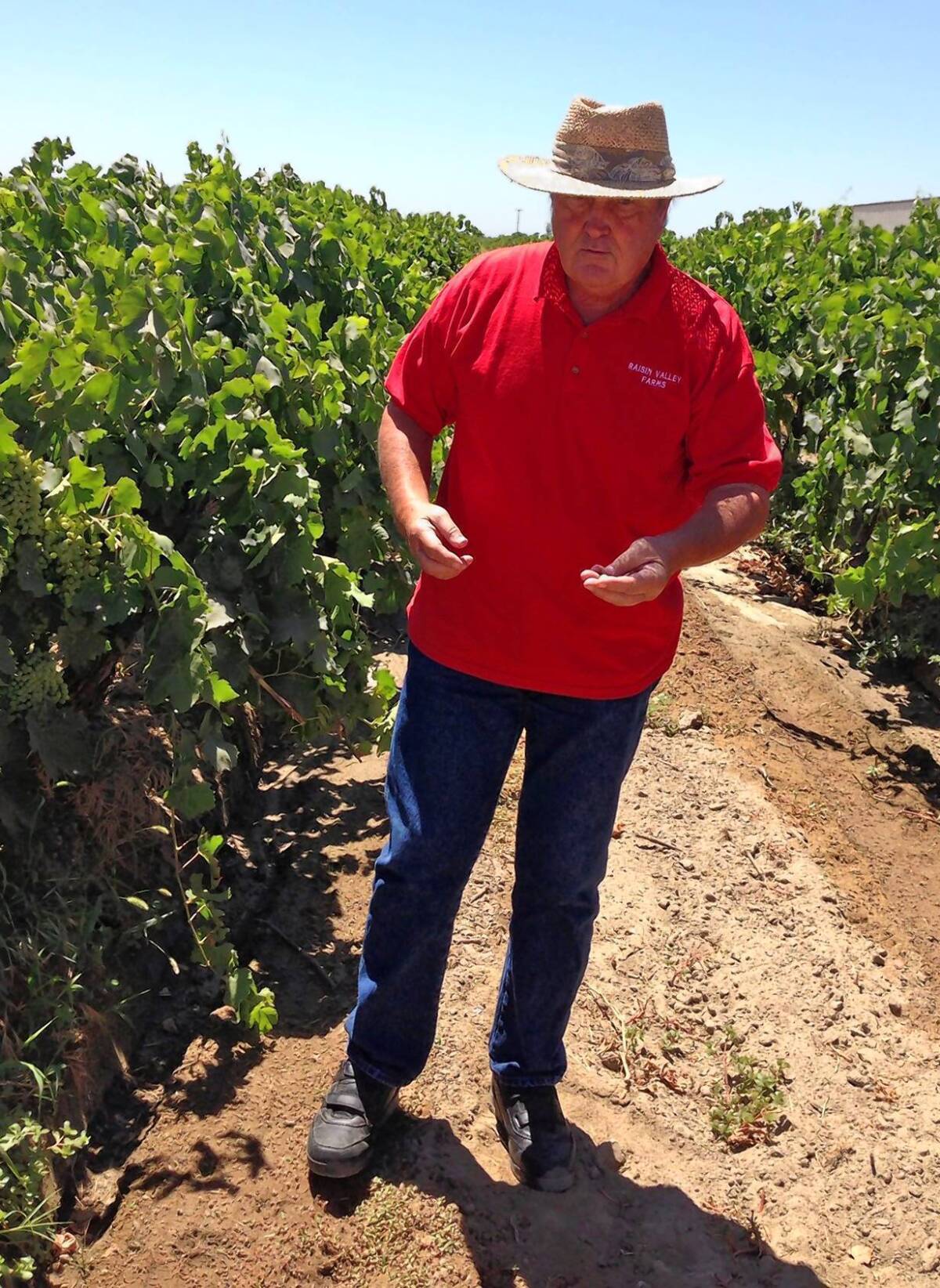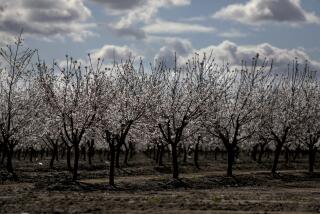Another wrinkle in raisin growers’ lawsuit

KERMAN, Calif. — “Look, look,” said Marvin Horne, squinting in the sun as he showed his wife a small bunch of Thompson seedless grapes just plucked from his lush green vines. He took the tiniest bite out of one and made a face. “We’re about two months away.”
In late August, when the grapes ripen, Marvin and Laura Horne will pick the fruit, lay it to dry on 2-by-3-foot sheets of white paper and like a thousand other farmers in the San Joaquin Valley, pray against rain as the crop slowly shrivels into raisins.
“We can always take one or two Pacific storms,” Horne said. “But the Gulf storms that come up from Mexico — those are the killers. They come into the valley and circle and circle and never go away.”
Weather is not the only thing that bedevils the Hornes.
They are small farmers, and you will not be shocked to know that they have a beef with the government. Last week, the U.S. Supreme Court unanimously sided with the couple in a complex case that may spell the end of a Depression-era federal program created to keep raisin prices stable, but which the Hornes say has devolved into an unconstitutional taking of their property. (The 5th Amendment precludes the government from taking property without just compensation.)
Last March, when the case was argued, justices seemed put off. Justice Elena Kagan wondered whether the issue was “a taking, or it’s just the world’s most outdated law.”
Justice Antonin Scalia, channeling Jack Benny, suggested government wanted “your raisins or your life.”
That sounded about right to the Hornes, who say they process 4,500 tons of raisins annually, or just over 1% of a nearly 350,000-ton domestic market. Part of that crop is from the Hornes’ vineyards, and part of it is from the couple’s Raisin Valley Farms Assn., which cleans, sorts and boxes fruit for about 60 growers.
Raisin farming may seem straightforward, but like so much of modern agriculture, it’s a complex industry, beset by rules, regulations and obscure marketing requirements that spring from another time and place. The contested raisin “marketing rule” works essentially by confiscating a portion of each farmer’s crop to keep prices up by regulating the supply.
“They knock on your door, they say, ‘You have two bins of raisins. We want one for our program. It’s for the common good,’ ” said Horne, 67. “That’s what they do in a communist state.”
The Raisin Administrative Committee, a group of growers and packers overseen by the U.S. Department of Agriculture, establishes the percentage of each year’s crop to be withheld. The reserves are doled out for use in federal school lunches or sold at below-market prices overseas.
Generally, the growers get no money for those raisins. Some years, the “reserve tonnage” has amounted to nearly half the crop.
About 10 years ago, after being asked to turn over 47% of their raisins, the Hornes rebelled.
They sold their fruit to the bakeries, restaurants and wholesalers who keep them afloat. The dozens of other farmers whose raisins they process did the same.
This did not please the government, which slapped the Hornes with a $484,000 bill — the cost of the estimated amount they failed to turn over — plus another $200,000 in penalties. Nor did it endear them to the many other raisin farmers and processors who have abided by the rules.
In fact, the huge cooperative known as Sun-Maid Growers of California, whose hundreds of farmers are responsible for a third of the state’s raisin output, filed a brief supporting the government. The Hornes, Sun-Maid said, have tried to gain an unfair advantage over their competitors.
Many farmers who favor the government orders also note that the system brought order to an uncertain and wildly fluctuating market after WWII.
It’s a familiar theme in the marketplace — the eternal tension between the collective good and the individual. No surprise: conservative and libertarian groups — the Cato Institute, the Chamber of Commerce, the state of Texas — filed briefs supporting the Hornes.
It’s a mind-set that raises doubts about the David vs. Goliath nature of the Hornes’ case. Are they the victims of a communitarian impulse run amok, or are they trying to take advantage by skirting rules that have served the industry well?
The Supreme Court did not rule on the overarching issue of whether the marketing orders were unconstitutional. Instead, the court ruled that the case can go forward in lower court without the Hornes first putting up the nearly $700,000 the government says they owe.
The Hornes do present a sympathetic picture.
“We almost lost our savings” paying legal bills, Marvin said. “What do you mean ‘almost’?” Laura shot back. “We did lose our savings.” (Other members of their association, they said, have chipped in.)
But their free-market absolutism could be put to the test if they prevail in court and the price of raisins plummets. No one will be there to support them.
More to Read
Start your day right
Sign up for Essential California for news, features and recommendations from the L.A. Times and beyond in your inbox six days a week.
You may occasionally receive promotional content from the Los Angeles Times.







